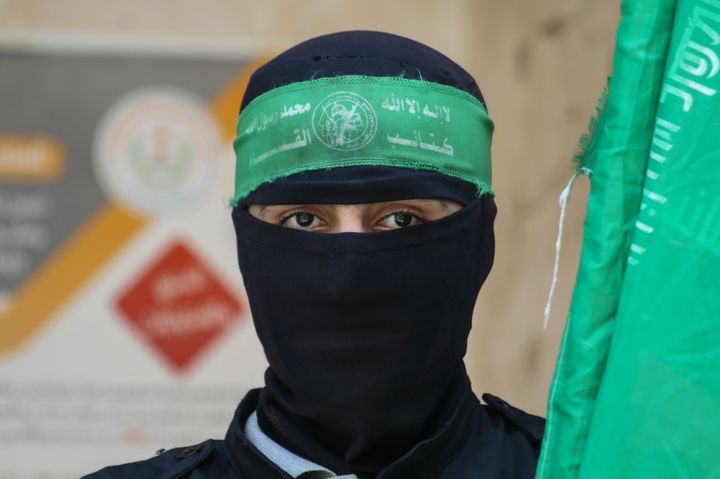
The name Hamas has appeared all over the world in recent weeks after the group’s attack on Israel – but who are they?
The Palestinian militant group made international news after launching a surprise attack on Israel on October 7 and killed more than 1,400 Israeli citizens, according to Tel Aviv.
They also took at least 239 people hostage and are still hiding most of them in the Gaza Strip.
It was the most intense cross-border attack Israel has faced in a generation, and it took Tel Aviv completely by surprise – despite its advanced security services.
In retaliation, Israel declared war, put Gaza under siege, launched a series of air strikes and have followed this up with a ground invasion.
The Hamas-run health ministry in Gaza claims more than 8,000 people have been killed by Israel’s actions since the war began.
Now caught up in a violent conflict with Israel, there’s a risk that Hamas’ violence could pull other Middle Eastern countries into a much wider war.
Here’s what you need to know about the group which Israeli PM Benjamin Netanyahu has vowed to “crush and destroy”.
Who are Hamas?
Hamas is an acronym for Harakat al-Muqawama al-Islamiya, which is translated as the Islamic Resistance Movement, and is a group backed by Shi’ite Iran.
Hamas emerged after splitting from the Muslim Brotherhood during the first Palestinian Intifada, or uprising, in 1987, although the groups still share the same basic ideology.
What are Hamas fighting for?
Hamas is based on three ideas – religion, charity and fighting the state of Israel – all laid out in its 1988 founding charter.
Essentially, the militants wants to eradicate the Jewish state of Israel, returning the land to its pre-1948 borders when the area was known just as Palestine.
And Hamas is prepared to do it through armed violence.
The group also installs teachers, surgeons, urban planners and police in the civil administration of Gaza – while still using brutality to keep the Palestinians in line.
For instance, in the 2014 Gaza war, its fighters abducted, tortured and murdered Palestinians it believed were “collaborating” with Israel.
It also has supporters across the Palestinian territories, and its leaders are spread across the Middle East.
It currently holds the 25 mile-long and 6 mile-wide Gaza Strip, one of two Palestinian territories. It is home to 2.23 million people, meaning it has one of the highest-population densities in the world.
More than 75% of its residents are registered as refugees or refugee descendants, according to the UN.
Isn’t Hamas elected?
Yes – although elections haven’t been held in close to two decades.
In the 2006 Gaza Strip elections, the Hamas-backed candidates secured the largest share of the votes, but the group then used force to secure its place by ousting all rival Fatah politicians from Gaza by force.
Fatah is a Palestinian movement still led by President Mahmoud Abbas, who is based in the West Bank and who heads up the Palestine Liberation Organisation. He has been in office since 2005.
Hamas claimed at the time that Abbas was conspiring against it, although the president has described the fallout from almost 20 years ago as a coup.
Since getting into office, Hamas has regularly exchanged rocket fire with Israel.
The militants’ leaders have occasionally offered long-term truces with Israel in exchange for a viable Palestinian state on all Palestinian territory occupied by Israel in the 1967 – but Tel Aviv reportedly does not trust such a negotiation.
What about its armed faction?
Known as the Izz ad-Din al Qassam bridges (or just the al-Qassam bridges), this particular arm of Hamas is notorious for its violent methods.
The BBC reported that Hamas had around 25,000 members in its military wing, and a network of underground tunnels across Gaza connecting its command centres. Supposedly, this network reaches across 310 miles.
Mohammed Deif, the secretive chief of the Hamas military wing, spent two years planning the weekend attacks which have been described as the deadliest day in Israel’s history.
Hamas fighters are known to use methods of terror, sending gunmen and suicide bombers into Israel under the guise of resisting the Israeli occupation.
The group carried out its first suicide bombing in 1993 working with the Islamic Jihad, in protest to the 1993 Oslo peace accords, negotiated by Israel and the PLO.
In the decades since – and after suffering heavy losses after the evacuation of the Israeli forces in Gaza in 2005 – it has become a well-trained paramilitary force.
What does the international community say?
The UK government has had Hamas on its list of terrorist organisations since 2021.
The BBC has received significant backlash for not referring to the group as terrorists in its reporting, although it has defended this by saying it stands by its editorial guidelines.
The US, the EU, Canada, Egypt and Japan also refer to Hamas as a designated terrorist organisation.
But, Hamas also has allies in the Middle East. It is part of a regional alliance including Iran, Syria, and the Shi’ite Islamist group Hezbollah in Lebanon.
